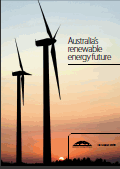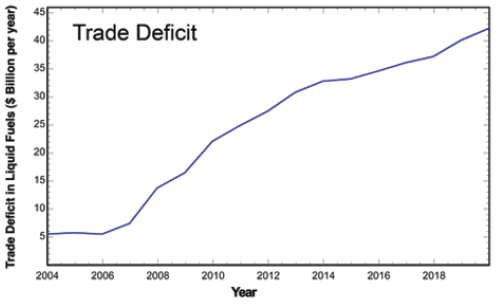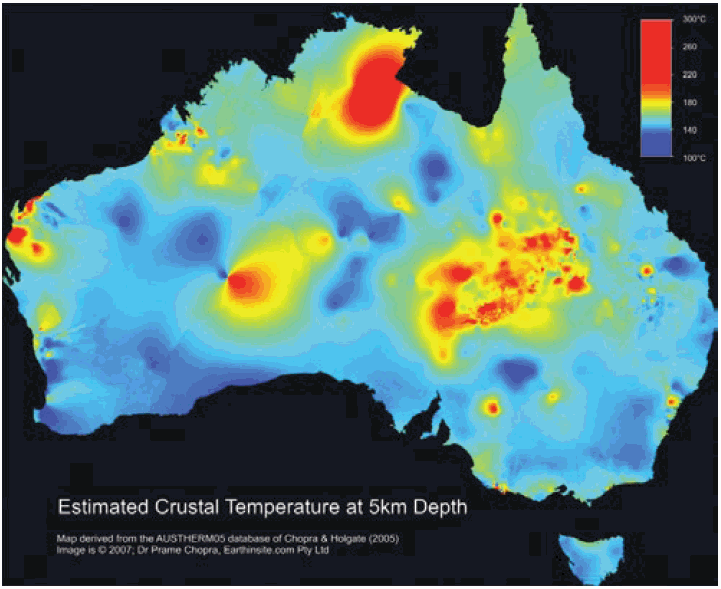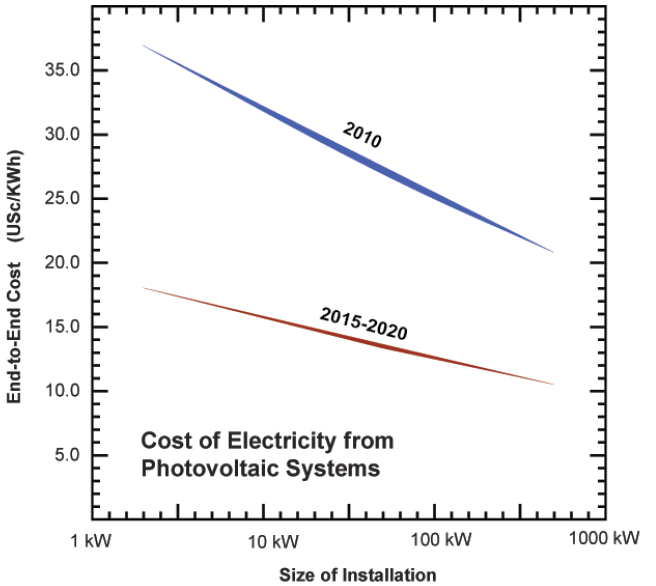|
|
|
|
|
|
|
News & Views item - March 2010 |
![]() Australian Academy of Science's Report on
Australia's
Renewable Energy Future.
(March 19, 2010)
Australian Academy of Science's Report on
Australia's
Renewable Energy Future.
(March 19, 2010)
The report
Australia's Renewable Future![]() arose from the Australian Academy of Science's public lecture series of
2008-09. It provides scientific analyses of existing and emerging renewable
energy technologies.
arose from the Australian Academy of Science's public lecture series of
2008-09. It provides scientific analyses of existing and emerging renewable
energy technologies.

Early in the report the Academy notes the increasing production and trade deficits for Australia and estimates it will reach $40 billion by 2020.

Australia’s production and demand for crude oil and condensates (million barrels per year).

Australia’s projected petroleum trade deficit.
Data source: Department of Industry, Tourism and Resources, Oil and Gas Resources of Australia 2003, www.ga.gov.au/image_cache/GA6111.pdf
The report goes on to assess eight sources of energy with thumbnail discussions of each followed by additional detail throughout the remainder of the report.
Wind turbines
Solar Thermal
Solar photovoltaic
Biomass combustion
Fuel cells
Geothermal
Wave energy
Tidal Energy
Summarising the eight sources:
Wind turbines
Though variable, wind turbines achieve a capacity factor (the ratio of average output power to the turbine’s rated or maximum power) of up to 50% in Australian wind farms, and require less than 3 to 6 months to recoup the energy used in their manufacture. Currently, large wind turbines are cheaper than any other renewable energy source, and under the Mandatory Renewable Energy Target (MRET) they compete head-to-head with coal-fired electricity generation at current costs. As fossil fuels are anticipated to incorporate their environmental costs with the introduction of an emissions trading scheme, the competitive position of wind turbines should continue to strengthen. Subject to amenity and aesthetic considerations, there are significant opportunities for small- and medium-sized turbines to be installed in urban and semi-urban areas such as sporting fields, parks, shopping centre car parks and industrial areas. Australia’s Renewable Energy Future.
Solar thermal
With appropriate energy storage, this technology offers potential load factors close to 100%, and is ideally suited for base-load power generation. It uses solar concentrators to focus sunlight for electricity generation. To put solar thermal generation systems into perspective, the Sun’s energy falling on Australia in one day is equal to half the total annual energy required by the whole world. To power all of Australia’s energy needs would require only 0.3% of the land surface to be devoted to solar power generation.
Solar photovoltaic
This technology provides a load factor of 15 to 20%. Solar photovoltaic cells are best for supplying peak demands in the middle of the day, but are less effective in managing the evening peak. Depending on feed-in tariffs, currently photovoltaics require between 4 and 10 years to recoup their investment and 2 to 3 years to recoup the energy used in their manufacture. Current costs are around $0.20 per kilowatt hour (kWh), but with the new technologies currently under development, generation costs are expected to reduce significantly. Solar photovoltaic systems are suited to domestic grid-connect power applications.
Biomass combustion
Potentially able to offer a high load factor, and a 2-year energy payback timescale, these provide a useful supplement to coal in centralised power stations. In semi-rural facilities, the process heat could be used for domestic applications.
Fuel cells
Fuel cells process gas to produce both electricity and heat. Both can be used in a domestic environment to give greater than 80% net efficiency, far exceeding conventional centralised power generation efficiencies, which in Australia are less than 30% for brown coal generators. In the near term, we can expect the following technologies to come on-line for exploitation.
Geothermal
This relies on producing superheated steam in radioactively heated ‘hot rock’ granite deposits to generate electricity. This process works best when the substrate rock (approximately 5 kilometres deep) has been heated to over 250 degrees Celsius (oC). Fortunately, Australia has several such deposits, notably in the Cooper and Galilee Basins located close to the boundary of New South Wales, Queensland and the Northern Territory.15 A cubic kilometer of hot granite at 250oC has the stored energy equivalent of 20 million barrels of oil. This technology is in development in Australia by several Australian companies at various levels of operation.
Wave energy
This technology has been well demonstrated overseas, and has shown to be viable in a number of different modes developed in Australia. Wave energy densities to the south of Australia are very high, with potential to offer very high load factors.
Tidal energy
The efficiency of tidal energy depends on the cube of the tidal current. In Australia, only a few locations provide suitable conditions, but this may be useful in niche areas such as supplying the energy needs of some remote settlements.
____________________________________________________
Finally the Academy offers twenty-five options for Australia to consider for development which are an outgrowth of the lecture series from which the report is derived.
Consider increasing public education with clear guidelines for allowable noise levels and visual amenity to encourage the establishment of wind farms and other sources of renewable energy, such as solar thermal and biomass generation, on privately-owned land.
Consider a national system of feed-in tariff rates for all forms of renewable and sustainable energy in a policy setting that encourages community power schemes, small and medium businesses, and other organisations to install renewable generation. The ACT feed-in tariff legislation is an excellent template for this and the New South Wales ‘gross’ feed-in tariff scheme provides innovative guidance.
Consider setting an appropriate national digression rate on feed-in tariffs.
Consider a national system of feed-in tariff rates for combined heat and power (CHP) domestic generation.
Consider setting an appropriate digression rate feed-in tariff rates for CHP domestic generation.
Consider government incentives to construct industrial scale CHP plants for base-load management.
Consider setting national standards governing the level and type of sulphur compounds in commercially-supplied natural gas (compressed natural gas, liquefied natural gas, liquefied petroleum gas) or biofuels (biogas and bio-alcohols).
Consider giving priority support to geothermal energy and solar thermal energy such that they become major national energy sources. Australia’s Renewable Energy Future.
Consider co-location of geothermal and solar thermal electrical energy generation stations.
Consider linking geothermal and solar thermal electrical energy generation with the national electricity grid through high voltage direct current (HVDC) transmission line technology.
Consider providing incentives or support to heavy industry located on the coasts to use wave and tidal energy.
Consider fast tracking the installation of smart meters in all Australian households, and phase in the introduction of time-of-use pricing, including dynamic peak pricing at times of high demand offset by lower prices at other times.
Consider integrating HVDC technology to transmit energy from the renewable energy production sites to cities and provide the HVDC system with efficient intercity links to allow for energy exchange as demand varies.
Consider providing incentives for the development of distributed power generation by fuel cells on both the domestic and small country town scales to stabilise base-load requirement and eliminate transmission losses.
Consider encouraging the development of a coast-to-coast integrated national natural gas distribution network.
Consider providing incentives for the greater adoption of liquefied natural gas to replace diesel and petrol.
Consider incentives to encourage the use of electrical or natural gas fuel cell electric hybrid vehicles, especially in cities.
Consider upgrading the interstate rail network to carry large loads, and link container ports or roll-on/roll-off facilities to encourage efficient distribution of goods.
Consider placing research and development priority on technological options for further reducing carbon and other emissions from shipping.
Consider measures to encourage and support the retrofit of all existing houses and apartments to at least a three star energy rating.
Consider a national seven star energy standard for all new houses by 2015.
Consider a national nine star energy rating for houses constructed after 2020.
Consider measures to encourage maximum standby power requirements on all domestic appliances and zero standby power usage where practical by 2015.
Consider a national scheme for feed-in tariff returns which encourages a high degree of domestic participation.
Consider dedicated Commonwealth and state government funding for Australian universities and research organisations to advance renewable energy research, from pure and applied research to development and commercialisation.

Modelled crustal energy content at 5 km depth, as
presented by Budd, Holgate, Gerner, Ayling and Barnicoat at the
Australian Geothermal Conference 2009: The temperature data contained in this
image was derived from proprietary
information owned by Earth Energy Pty Ltd, ABN 078 964 735, further developed by
Geoscience Australia. Published with
the permission of Earthinsite.com Pty Ltd and Geoscience Australia to the
AAS.
________________________________________________________________

The whole of lifetime costs of energy production from photovoltaic systems as a function of size of the installed system.
The cost includes the infrastructure (mounting systems, inverters, grid connection) as well as the basic costs of the panels.
These costs are expected to fall by 50% by 2015–21.